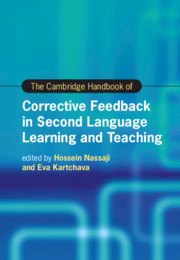Book contents
- The Cambridge Handbook of Corrective Feedback in Second Language Learning and Teaching
- Cambridge Handbooks in Language and Linguistics
- The Cambridge Handbook of Corrective Feedback in Second Language Learning and Teaching
- Copyright page
- Contents
- Figures
- Tables
- Contributors
- Acknowledgments
- Introduction Corrective Feedback in Second Language Teaching and Learning
- Part I Theoretical Perspectives on Corrective Feedback
- Part II Methodological Approaches in the Study of Corrective Feedback
- Part III Different Delivery Modes of Corrective Feedback
- Part IV Feedback Provider, Feedback Intensity, and Feedback Timing
- Part V Corrective Feedback and Language Skills
- Part VI Contexts of Corrective Feedback and Their Effects
- 22 Corrective Feedback in Second versus Foreign Language Contexts
- 23 Corrective Feedback in Computer-Mediated versus Face-to-Face Environments
- 24 Corrective Feedback in Mobile Technology-Mediated Contexts
- 25 Oral Corrective Feedback in Content-Based Contexts
- Part VII Learners’ and Teachers’ Feedback Perspectives, Perceptions, and Preferences
- Part VIII Individual Differences, Tasks, and Other Language- and Learner-Related Factors
- Index
- References
22 - Corrective Feedback in Second versus Foreign Language Contexts
from Part VI - Contexts of Corrective Feedback and Their Effects
Published online by Cambridge University Press: 26 February 2021
- The Cambridge Handbook of Corrective Feedback in Second Language Learning and Teaching
- Cambridge Handbooks in Language and Linguistics
- The Cambridge Handbook of Corrective Feedback in Second Language Learning and Teaching
- Copyright page
- Contents
- Figures
- Tables
- Contributors
- Acknowledgments
- Introduction Corrective Feedback in Second Language Teaching and Learning
- Part I Theoretical Perspectives on Corrective Feedback
- Part II Methodological Approaches in the Study of Corrective Feedback
- Part III Different Delivery Modes of Corrective Feedback
- Part IV Feedback Provider, Feedback Intensity, and Feedback Timing
- Part V Corrective Feedback and Language Skills
- Part VI Contexts of Corrective Feedback and Their Effects
- 22 Corrective Feedback in Second versus Foreign Language Contexts
- 23 Corrective Feedback in Computer-Mediated versus Face-to-Face Environments
- 24 Corrective Feedback in Mobile Technology-Mediated Contexts
- 25 Oral Corrective Feedback in Content-Based Contexts
- Part VII Learners’ and Teachers’ Feedback Perspectives, Perceptions, and Preferences
- Part VIII Individual Differences, Tasks, and Other Language- and Learner-Related Factors
- Index
- References
Summary
This chapter summarizes the main findings regarding the effect of the variable instructional context on oral corrective feedback (CF) provision and learner uptake in second language (SL) and foreign language (FL) settings. Although there are other intervening variables in CF provision, such as learners’ individual variables, CF type, and task-related factors, instructional context seems to play an important role in the way teachers provide CF to oral errors, as well as in learners’ reaction to those errors. Lesson orientation appears to be a key factor and, thus, in those contexts that teachers, learners, and activities focus on language forms, such as FL settings, CF seems to be more effective, especially recasts. In classrooms that are more meaning- or content-oriented, such as SL, immersion or secondary school content and language integrated learning (CLIL) classrooms, the rates of uptake are lower and more explicit CF types (such as metalinguistic information or elicitation) are needed. This review of the impact of context on CF provision and uptake leads to some pedagogical implications.
Keywords
- Type
- Chapter
- Information
- The Cambridge Handbook of Corrective Feedback in Second Language Learning and Teaching , pp. 473 - 493Publisher: Cambridge University PressPrint publication year: 2021
References
- 4
- Cited by

